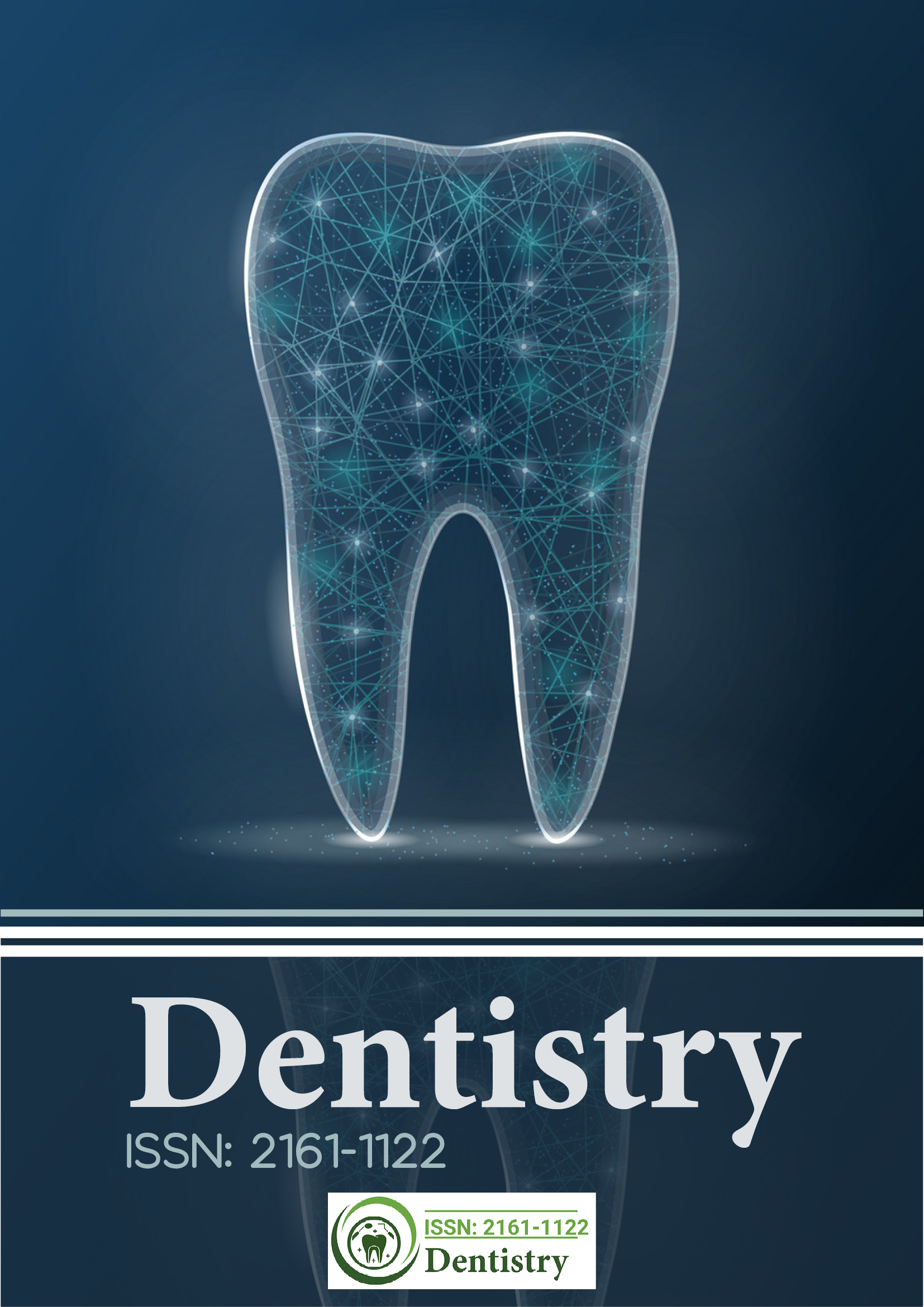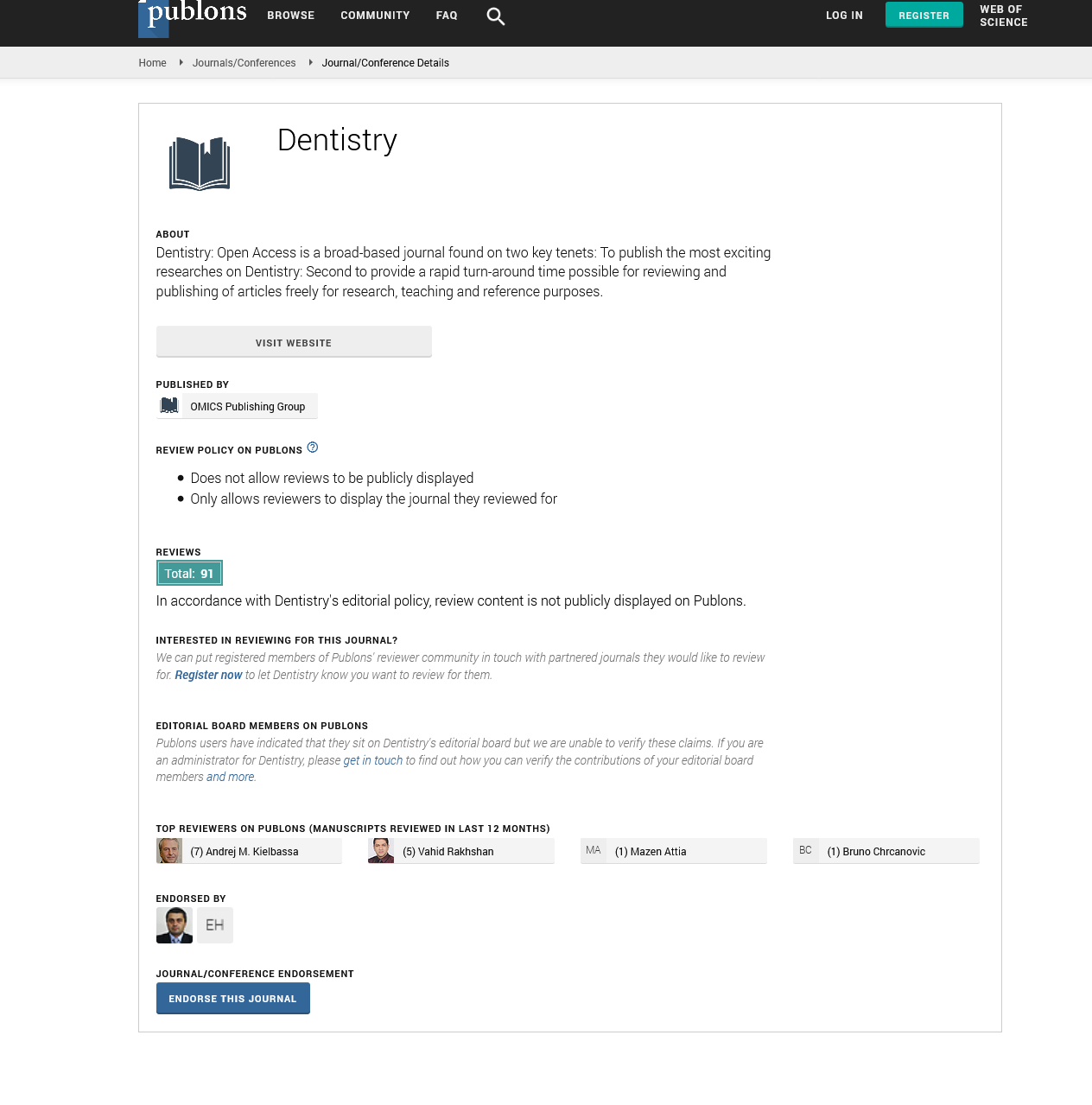Citations : 2345
Dentistry received 2345 citations as per Google Scholar report
Indexed In
- Genamics JournalSeek
- JournalTOCs
- CiteFactor
- Ulrich's Periodicals Directory
- RefSeek
- Hamdard University
- EBSCO A-Z
- Directory of Abstract Indexing for Journals
- OCLC- WorldCat
- Publons
- Geneva Foundation for Medical Education and Research
- Euro Pub
- Google Scholar
Useful Links
Share This Page
Journal Flyer

Open Access Journals
- Agri and Aquaculture
- Biochemistry
- Bioinformatics & Systems Biology
- Business & Management
- Chemistry
- Clinical Sciences
- Engineering
- Food & Nutrition
- General Science
- Genetics & Molecular Biology
- Immunology & Microbiology
- Medical Sciences
- Neuroscience & Psychology
- Nursing & Health Care
- Pharmaceutical Sciences
Opinion - (2025) Volume 15, Issue 2
Microbiome-Mediated Factors Affecting Infections after Major Oral Cavity Cancer Surgery
Tom Dahl*Received: 26-May-2025, Manuscript No. DCR-25-29708; Editor assigned: 28-May-2025, Pre QC No. DCR-25-29708 (PQ); Reviewed: 11-Jun-2025, QC No. DCR-25-29708; Revised: 18-Jun-2025, Manuscript No. DCR-25-29708 (R); Published: 25-Jun-2025, DOI: 10.35248/2161-1122.25.15.733
Description
Major oral cavity cancer surgeries often involve extensive tissue removal and reconstructive procedures, creating conditions that increase the risk of infectious complications. Postoperative infections can lead to delayed wound healing, flap failure and prolonged hospitalization. The oral microbiome, a complex microbial ecosystem, has emerged as an important factor influencing infection susceptibility. Variations in microbial composition, diversity and functional potential may contribute to the onset and progression of infections after surgery. This review examines the evidence supporting the role of the oral microbiome in postoperative infectious complications, factors affecting microbial dynamics and potential clinical implications for patient management.
Oral cavity cancers are commonly treated with surgical resection, often combined with reconstructive procedures to restore function and aesthetics. Despite advances in surgical technique and perioperative care, postoperative infections remain a significant challenge. These infections are associated with increased morbidity, longer hospital stays and higher healthcare costs. The oral cavity harbors a diverse microbiome, consisting of bacteria, fungi, viruses and archaea, which maintain oral homeostasis and influence systemic health. Dysbiosis of this microbial community may contribute to infection development in patients undergoing major oral cancer surgery. Understanding the relationship between the oral microbiome and postoperative infections is essential for improving patient outcomes.
Surgical impact on microbial communities
Major oral cavity surgery disrupts tissue integrity, introduces foreign materials and often involves prolonged operative times, all of which affect the oral microbiome. Tissue resection and flap reconstruction can alter local oxygenation and nutrient availability, favoring the growth of anaerobic and facultative pathogens. Surgical trauma also impairs mucosal barriers, making tissues more susceptible to bacterial colonization. Antibiotic prophylaxis and perioperative antiseptic protocols influence microbial composition, but may not fully prevent opportunistic infections. Monitoring microbial shifts before and after surgery provides insight into infection risk and potential preventive strategies.
Microbiome analysis methods
Advances in sequencing technologies have enabled detailed characterization of the oral microbiome. High-throughput sequencing allows taxonomic profiling, while shotgun metagenomics provides insights into microbial functional potential. Longitudinal sampling before and after surgery permits assessment of microbial shifts and their association with clinical outcomes. Bioinformatic analyses, including diversity metrics, differential abundance testing and network modeling, reveal patterns predictive of infection. Integrating microbiome data with patient demographics, comorbidities and perioperative factors enhances the understanding of infection risk.
Factors influencing postoperative infections
Several factors interact with the oral microbiome to influence infection risk. Host immune status, nutritional state, smoking, diabetes and other comorbidities affect microbial composition and pathogen susceptibility. Surgical factors, such as duration, extent of resection, flap type and use of drains or prosthetics, also contribute. Perioperative antibiotic use, oral hygiene and oral rinses modify microbial communities and may prevent or promote infection depending on their timing and spectrum. Understanding these interactions is critical for identifying patients at higher risk and implementing targeted interventions.
Clinical implications
Recognizing the role of the oral microbiome in postoperative infections offers opportunities for clinical intervention. Preoperative assessment of microbial composition may identify high-risk patients who could benefit from targeted antimicrobial therapy or microbiome modulation. Optimizing perioperative antibiotic protocols, maintaining oral hygiene and managing comorbidities can reduce infection incidence. Additionally, strategies such as probiotics, prebiotics, or selective antimicrobial treatments may support microbial balance and improve outcomes. Personalized approaches based on microbial profiling have the potential to enhance recovery and reduce complication rates.
The oral microbiome plays a significant role in the development of infectious complications following major oral cavity cancer surgery. Dysbiosis, reduced microbial diversity and enrichment of pathogenic taxa increase susceptibility to postoperative infections. Surgical trauma, host factors and perioperative interventions interact with the microbiome, influencing infection risk. Advances in sequencing technologies and bioinformatic analyses provide a framework for identifying microbial signatures predictive of complications. Understanding these microbial contributions allows clinicians to implement preventive strategies, optimize perioperative care and improve patient outcomes. Continued research integrating multi-omic data and longitudinal monitoring will further clarify the relationship between the oral microbiome and postoperative infectious complications.
Citation: Dahl T (2025). Microbiome-Mediated Factors Affecting Infections after Major Oral Cavity Cancer Surgery. J Dentistry. 15:733.
Copyright: © 2025 Dahl T. This is an open-access article distributed under the terms of the Creative Commons Attribution License, which permits unrestricted use, distribution, and reproduction in any medium, provided the original author and source are credited.

